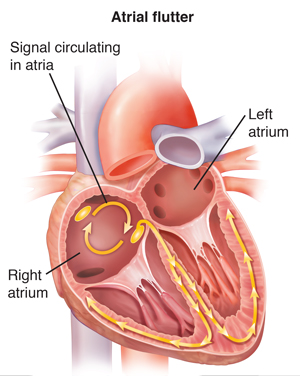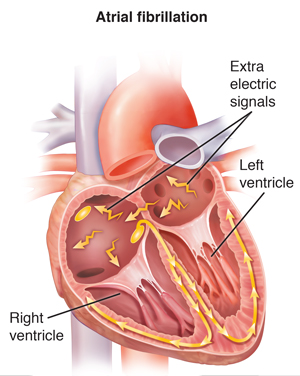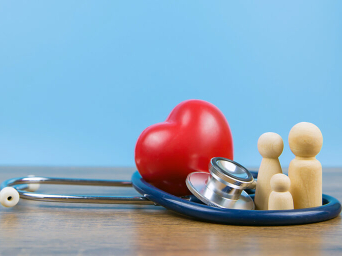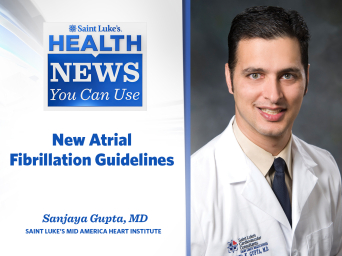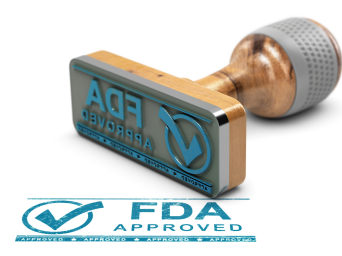Atrial Fibrillation (AFib)
Saint Luke’s Mid America Heart Institute provides region-leading comprehensive management for atrial fibrillation at all stages of the disease through our Comprehensive AFib Program. The Saint Luke’s Comprehensive Atrial Fibrillation Program begins with helping patients modify their Afib risk factors through weight loss, treatment of sleep apnea, daily moderate exercise, limiting alcohol intake, and treating other risk factors, including hypertension and diabetes.
Patients with atrial fibrillation are encouraged to work together with our clinicians to modify their risk factors and improve their likelihood of long-term maintenance of sinus rhythm in conjunction with other treatments such as antiarrhythmic therapy or catheter ablation.
Saint Luke’s Atrial Fibrillation Clinic
Saint Luke’s Atrial Fibrillation Clinic features a highly specialized team of electrophysiologists, electrophysiology nurses, and nurse practitioners who specialize in treating patients with atrial fibrillation, fibrillation, a type of irregular heart rhythm.
Saint Luke’s is often the region’s only hospital to offer patients advanced investigational treatments. For example, our patients can benefit from a left atrial appendage occlusion procedure, such as a WATCHMAN® device, which is an alternative to blood thinners, studied at Saint Luke's prior to FDA approval and used to prevent stroke in atrial fibrillation. We also were the first hospital in the region to offer pulsed field ablation, a novel type of ablation that selectively targets just the tissues causing Afib.
Call 816-751-8415 for a consultation.
What is Atrial Flutter/Atrial Fibrillation?
What Is Atrial Flutter/Atrial Fibrillation?
The heart has its own electrical system. This system makes the signals that start each heartbeat. The heartbeat begins in 1 of the 2 upper chambers of the heart (atria). A problem can make the atria beat faster than normal. The atria may beat fast but still evenly. This problem is called atrial flutter. If the atria beat very fast and also unevenly, it is called atrial fibrillation (AFib).
Causes of Atrial Flutter and Atrial Fibrillation
Causes of these problems can include:
-
Previous heart attack
-
High blood pressure
-
Thyroid problems
In many cases, the cause is unknown.
When the Atria Beat Too Fast
The atria may beat fast only once in a while. This is called a paroxysmal heart rhythm problem. If they beat fast all the time, it is a chronic problem.
Atrial Flutter
With atrial flutter, electrical signals travel around and around inside the atria. These circling signals make the atria beat too fast:
-
Atrial flutter can cause symptoms similar to AFib. It can also lead to the even faster, uneven rhythms of AFib.
Atrial Fibrillation (AFib)
With AFib, cells in the atria send extra electrical signals. These extra signals make the atria beat very fast. They also beat unevenly:
-
The atria beat so fast and unevenly that they may quiver instead of contracting. If the atria don’t contract, they don’t move enough blood into the 2 lower chambers of the heart (ventricles). This can cause you to feel dizzy or weak.
-
Blood that doesn’t keep moving can pool and form clots in the atria. These clots can move into other parts of the body and cause serious problems such as a stroke.
Symptoms of Atrial Flutter and AFib
These symptoms include the following:
-
Palpitations (a fluttering, fast heartbeat)
-
Weakness or tiredness
-
Shortness of breath
-
Chest pain or tightness
-
Dizziness or lightheadedness
-
Fainting spells
Understanding Atrial Fibrillation
Understanding Atrial Fibrillation (AFib)
Atrial fibrillation (AFib) is the most common type of arrhythmia. An arrhythmia is any problem with the speed or pattern of the heartbeat. AFib causes fast, chaotic electrical signals in the atria. This makes it hard for the heart to work as it should. It affects how much blood your heart can pump out to the body.
AFib may occur once in a while and go away on its own. This is called paroxysmal. Or it may continue for longer periods. This is called persistent.
AFib can lead to serious problems, such as stroke. Your healthcare provider will need to watch and manage your condition.
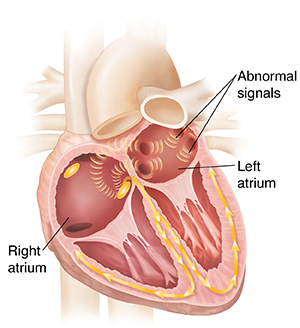
What happens during atrial fibrillation?
The heart has an electrical system. This sends signals to control the heartbeat. As the signals move through the heart, they tell the heart’s upper chambers (atria) and lower chambers (ventricles) when to squeeze (contract) and relax. This lets blood move through the heart and out to the body and lungs.
With AFib, the atria get abnormal signals. This causes them to contract in a fast and irregular way. They are out of sync with the ventricles. The atria have a harder time moving blood into the ventricles. Blood may then pool in the atria. This increases the risk for blood clots and stroke. The ventricles may contract too quickly and irregularly. They may not pump blood to the body and lungs as well as they should. This can weaken the heart muscle over time. This can lead to heart failure. Heart failure means the heart muscle can’t pump blood well.
What causes atrial fibrillation?
AFib is more common in older adults. It has many possible causes:
- Older age
-
Coronary artery disease
-
Heart valve disease
-
Heart attack
-
Heart surgery
-
High blood pressure
-
Thyroid disease
-
Diabetes
-
Lung disease
-
Sleep apnea
-
Heavy alcohol use
In some cases of AFib, healthcare providers don't know the cause.
What are the symptoms of atrial fibrillation?
AFib may not cause symptoms. If symptoms do occur, they may include:
-
A fast, pounding, irregular heartbeat
-
Shortness of breath
-
Tiredness
-
Dizziness or fainting
-
Chest pain
How is atrial fibrillation treated?
Treatments for AFib can include any of the below.
-
Medicines. You may be prescribed:
-
Heart rate medicines to help slow down the heartbeat
-
Heart rhythm medicines to help the heart beat more regularly
-
Blood thinners or anti-clotting medicines to help reduce the risk for blood clots and stroke
-
-
Left atrial appendage closure. Your healthcare provider may advise this to prevent stroke. You may need it if you are at high risk for stroke but have problems taking blood-thinner (anticoagulant) medicines. This is a procedure done through a catheter in the groin. A device is placed in the part of the heart. This is where most clots form. This area is called the left atrial appendage (LAA). It's a pouch-like structure in the muscle wall of the left atrium. The device closes off the LAA. This prevents clots moving from the heart to the brain and causing a stroke.
-
Electrical cardioversion. Your healthcare provider uses special pads or paddles to send 1 or more brief electrical shocks to the heart. This can help reset the heartbeat to normal.
-
Ablation. Long, thin tubes (catheters) are threaded through a blood vessel to the heart. In the heart, the catheters send out hot or cold energy to the places that cause the abnormal signals. This destroys the problem tissue or cells. This improves the chances that your heart will stay in normal rhythm without using medicines. If your heart rate and rhythm can’t be controlled, you may need an AV node ablation and a pacemaker. These will help control the heart rate and regularity of the heartbeat.
-
Surgery. Your healthcare provider may use a method to create scar tissue in the parts of the heart causing the abnormal signals. The scar tissue disrupts the abnormal signals. This may stop AFib from occurring. Most often, the left atrial appendage is closed off as well.
-
Hybrid surgical-catheter ablation for AFib. This is used for people with AFib that continues or is hard to treat. It combines surgery with a catheter ablation. First, the surgeon makes small cuts (incisions) between the ribs in the chest or in the abdomen near the sternum. The surgeon puts a scope through the incisions. This is done to get to the backside and other areas of the heart. Energy is sent to the surface of the atria. This disrupts the abnormal electrical signals. Then a catheter is put into a vein in the groin. The catheter is guided into the heart. Using the catheter, radiofrequency ablation is done. This destroys any other tissue inside the heart that is causing the AFib. It's also done to assess the success of the surgery. This hybrid treatment may work better to block the abnormal electrical signals. It may be a more permanent fix for persistent AFib.
What are possible complications of atrial fibrillation?
Complications can include:
-
Blood clots
-
Stroke
- Dementia
-
Heart failure
When should I call my healthcare provider?
Call your healthcare provider right away if you have any of these:
-
Symptoms that don’t get better with treatment, or get worse
-
New symptoms
What is electrical cardioversion?
Cardioversion is a procedure used to reset an abnormal heart rhythm to a normal rhythm. This procedure is used when the heart is beating very fast or irregular. This is called an arrhythmia. Arrhythmias can cause problems. These include fainting, stroke, heart attack, and even sudden cardiac death. With electrical cardioversion, a high-energy shock is sent to the heart to reset a normal rhythm. It's different from chemical cardioversion. In this procedure, medicines are used to try to restore a normal rhythm.
A special group of cells normally begin the electrical signal to start your heartbeat. These cells are in the sinoatrial node. This node is in the right atrium, the upper right chamber of the heart. The signal quickly travels down the heart’s conducting system on the way to the ventricles, the two lower chambers of the heart. The signal sets off nearby parts of the heart to contract as it travels. This organized pattern helps the heart contract in a coordinated way.
Various problems can disrupt this signaling pathway and lead to abnormal heart rhythms. The heart might beat very quickly. This would not leave it enough time to fill with enough blood between beats. This can prevent your heart from pumping enough blood to the body. Some abnormal heart rhythms raise your risk of stroke. Some also raise the risk of life-threatening rhythms that can lead to sudden death. Cardioversion interrupts the abnormal signaling and lets the heart reset itself back into a normal rhythm.
Cardioversion is usually a scheduled procedure. But sometimes healthcare providers need to do it on an urgent basis if symptoms are severe. You will likely be given medicine to put you to sleep before delivering the shocks. Cardioversion is not the same as defibrillation. Both use shocks to reset the heart. But in a cardioversion, the shock is synchronized with the heartbeat. Defibrillation is typically done in an emergency to stop very severe rhythms that can cause sudden death.
Why might I need an electrical cardioversion?
Electrical cardioversion can help treat several different abnormal heart rhythms. It's commonly used to treat sustained arrhythmias, such as atrial fibrillation (Afib). With this condition, the atria of the heart quiver instead of beating the right way. Symptoms of Afib may include shortness of breath, fatigue, and a very fast heartbeat. It can also increase risk for stroke.
If this is your first time having Afib, your healthcare provider may be more likely to suggest cardioversion. Your provider may also want you to have it if you have ongoing Afib, especially if it gives you severe symptoms. Electrical cardioversion works better and is used more often than chemical cardioversion. It's also faster.
Your healthcare provider may not recommend cardioversion if you don't have symptoms from the Afib or if your symptoms are very minor. It also may not be recommended if you are elderly, if you have had Afib a long time, or if you have other major medical problems. Other treatments might be better for you, like heart rate control with medicines.
Electrical cardioversion is also useful for treating other abnormal heart rhythms, like atrial flutter, which is similar to Afib. It can also be used to treat certain kinds of supraventricular tachycardias and ventricular tachycardia. These types of heart rhythms can cause heart rates that are too fast. This can prevent the heart from pumping enough blood.
Before trying electrical cardioversion, your healthcare provider may try to reset the heart rate in other ways. This might include the Valsalva maneuver. This is a method where you hold your breath and increase the pressure in your belly. This can help bring the heart rate down. Your healthcare provider may then try medicines to change the rhythm to normal. If these methods don’t work, electrical cardioversion is often the next step. In other cases, electrical cardioversion is the first recommended step.
You may need an electrical cardioversion soon if you have severe symptoms from your heart rhythm.
What are the risks of electrical cardioversion?
Although most people have a successful electrical cardioversion, it does have certain risks. Your own risks may vary based on your age, the type of abnormal heart rhythm you have, and your other medical conditions. Ask your healthcare provider about your risks.
Rarely, the procedure causes a more dangerous heart rhythm. If that happens, someone will give you medicines or a stronger electric shock to stop this rhythm. Some other risks are:
- Problems breathing if you had medicine (sedation) to help you sleep during the procedure
- Other less dangerous abnormal rhythms
- Slow heart rate afterwards
- Temporary low blood pressure
- Heart damage (usually temporary and without symptoms)
- Heart failure
- Skin damage/irritation
- Dislodged blood clot, which can cause stroke or other problems
In certain situations, healthcare providers lower this last risk by giving medicines to help prevent clots (blood thinners). They give people these medicines before and after the procedure.
In some cases, the cardioversion may not be able to reset a normal heart rhythm. There is also a risk that you might go back to your abnormal rhythm shortly after your cardioversion. Sometimes people need to take medicines to help control the heart rhythm before the procedure. They may need to take medicines after the procedure and prevent the problem from happening again.
How do I get ready for an electrical cardioversion?
Talk with your healthcare provider about what you should do to get ready for your electrical cardioversion. Follow any directions you are given for not eating or drinking before the procedure.
Follow your healthcare provider’s instructions about what medicines to take before the procedure. This includes any medicines to prevent abnormal rhythms. Don’t stop taking any medicine unless your healthcare provider tells you to do so. You might need blood tests before the procedure to make sure the procedure is safe to do.
If you are at higher risk of blood clots, your healthcare provider may want you to take anticlotting medicine. These are commonly taken for several weeks before and after the procedure. Not everyone needs this medicine, but most people do. You are likely to need anticlotting medicine if your abnormal rhythm has lasted more than 48 hours or if you have had a blood clot in the past.
Your healthcare provider may want a transesophageal echocardiography (TEE) test before the procedure. This test is a special kind of ultrasound. A thin, flexible tube is put down your throat and into your esophagus. Here, the tube is close to your heart. It lets your healthcare provider see if you have any blood clots in the heart. Your cardioversion will be delayed if a clot is found. You’ll likely need to take blood-thinner medicine for a while until your risk for clots is low. You may have a repeat TEE to make sure the clot has gone away. It’s important to take any blood-thinning medicines exactly as your healthcare provider tells you.
What happens during an electrical cardioversion?
Talk with your healthcare provider about what to expect during your procedure. It may differ if you need an urgent or emergency electrical cardioversion. In general, you can expect the following:
- Soft electrode pads are placed on your chest and maybe on your back. You might need some areas of skin shaved to get the electrode pads to stick.
- These electrodes will connect to a cardioversion machine.
- You will get medicine through a vein in your arm to make you fall asleep.
- Using the cardioversion machine, a programmed high-energy shock is sent to your heart. This should convert your heart back to a normal rhythm.
- Your team will closely keep track of your heart rhythm. They will watch for any signs of complications.
- The procedure only takes a few minutes. When it is done, you will wake up.
What happens after an electrical cardioversion?
Ask your healthcare provider about what to expect. You will likely:
- Wake up 5 to 10 minutes after the procedure
- Be closely watched for signs of complications for several hours
- Feel sleepy for several hours after the cardioversion. Arrange to have someone drive you home
- Go home the same day as the procedure
- Have some redness or soreness on your chest that lasts for a few days
Ask your healthcare provider about what medicines you’ll need to take when you get home. Many people need to take an anticlotting medicine, such as warfarin or another blood thinner. Some people also need medicines to prevent abnormal heart rhythms. Take all your medicines exactly as your healthcare provider tells you. Tell your healthcare provider right away if any of your symptoms come back.
Next steps
Before you agree to the test or procedure make sure you know:
- The name of the test or procedure
- The reason you are having the test or procedure
- What results to expect and what they mean
- The risks and benefits of the test or procedure
- What the possible side effects or complications are
- When and where you are to have the test or procedure
- Who will do the test or procedure and what that person’s qualifications are
- What would happen if you did not have the test or procedure
- Any alternative tests or procedures to think about
- When and how you will get the results
- Who to call after the test or procedure if you have questions or problems
- How much you will have to pay for the test or procedure
